Plan checklist
Vincent Property
1128 Juniper Court, Drag Lake
Planting plan created by The Land Between charity
Schedule A:
Plants & Property
Land Characteristics
This planting plan is designed based on the land characteristics identified during the day of the site visit. Plants are chosen according to the soil and light conditions on your property. The number of plants chosen for each planting compartment takes into account the square metre area of the space, as well as the amount of current vegetation cover. Your property is part of ecoZone: 5b
Land Characteristics by Compartment
| Length | Width | Area | pH | Soil | Moisture | Light | Height | |
|---|---|---|---|---|---|---|---|---|
| A | 0m | 0m | 0m2 | |||||
| B | 0m | 0m | 0m2 | |||||
| C | 4m | 0.2m | 1m2 | acidic | partial sun | |||
| D | 1.5m | 1m | 1.5m2 | dry | full sun, partial sun | |||
| E | 0m | 0m | 0m2 | acidic | dry | full sun | ||
| F | 1m | 1m | 1m2 | shade | ||||
| 6.5m | 0.37m | 3.5m2 |
Plant Selection Summary
The following shrubs and trees are chosen for their suitability and survivability given the current soil and light conditions in each compartment on your property, as well as preferable features.
| Plant Species | A | B | C | D | E | F | Potted | Bareroot | Wildflower |
|---|---|---|---|---|---|---|---|---|---|
| Ninebark | 3 | 3 | |||||||
| Chokecherry | 2 | 2 | |||||||
| Canadian Serviceberry | 3 | 3 | |||||||
| Blue Flag Iris | 16 | 16 | |||||||
| Cardinal Flower | 24 | 24 | |||||||
| Swamp Milkweed | 6 | 12 | 18 | ||||||
| Steeplebush | 6 | 6 | |||||||
| Sweet Oxeye | 24 | 24 | |||||||
| Smooth Wild Rose | 3 | 1 | 3 | 1 | |||||
| Lowbush Blueberry | 6 | 6 | |||||||
| Pearly Everlasting | 16 | 16 | |||||||
| Hairy Mountain Mint | 6 | 6 | |||||||
| Hoary Vervain | 3 | 3 | |||||||
| Bearberry | 5 | 5 | |||||||
| Pasture Rose | 3 | 3 | |||||||
| Creeping Juniper | 3 | 3 | |||||||
| Subtotal | 60 | 36 | 31 | 9 | 6 | 11 | 0 | 131 | |
| Totals | 142 | ||||||||
Plant Information
The following table summarizes key information about each plant selected for your property.
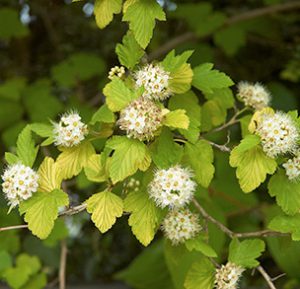
|
NinebarkHeight: 2-3m
The Common Ninebark is a very hardy, large (2-3m in height), deciduous shrub naturally occurring within riparian zones. This species is often planted as an ornamental shrub for its exfoliating bark which reveals reddish-light brown inner bark. This shrub is multi-stemmed with numerous horizontal and ascending branches creating a full, round shape. The Common Ninebark produces dull green, ovate to round shaped leaves with three to five lobes per leaf. During the fall the leaves turn brilliant yellow or dark purple. Between May and June, showy, bell-shaped flowers bloom in clusters on the terminal ends of the branches. During the summer, these flowers give way to small green or green-yellow berries which turn a bright red upon ripening.
|
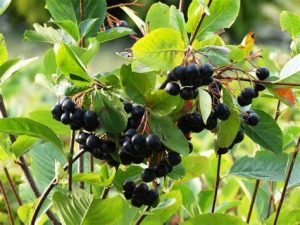
|
ChokecherryHeight: 6-9 m
The Chokecherry is a large deciduous shrub or small tree which grows between 6 and 9 m tall and is a member of the Rose family. It produces a twisted or crooked trunk as well as a narrow, oval to round crown composed of many slender branches. Leaves are alternately arranged, simple, have a deep green upper surface, and light matte green undersides with tufts of hair at the vein axils. During the fall, foliage turns a vibrant deep red to fire yellow or orange. Between May and June, small showy white flowers grow in cylindrical clusters on the terminal ends of branches. By mid-August, flowers turn into shiny deep red or black cherries, which hang in elongated clusters. The fruit is ripe by September and provides a food source for birds and small mammals. The Chokecherry is often found as pure stands forming thickets, or mixed with other early succession shrub and tree species. This fast-growing plant can quickly invade logged land, abandoned farms, and exposed shorelines. The fibrous and wide-spreading root system of this shrub make it an ideal plant for erosion control and bank stabilization. This species possesses the ability to withstand moderate flooding and drought.
|
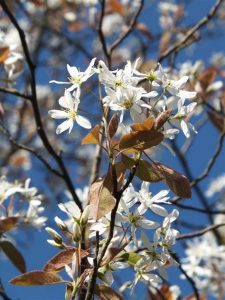
|
Canadian ServiceberryHeight: 3-5 m
The Canadian Serviceberry is a multi-stemmed shrub or small tree which grows from 3-5 m in a dense round form. This plant may also be known by the common names: Juneberry, Shadblow, or Shadbush. Early in the spring, prior to leaf development, clusters of fragrant, showy white flowers bloom along the branches. By July, these flowers give way to the fruiting bodies. The fruits are initially small, green berries, which grow to the size of blueberries and turn a deep purple-blue upon maturation during the fall. Leaves produced are finely toothed and spear-shaped. Throughout the summer, leaves are dark green and turn a dramatic orange-red during the fall.
|
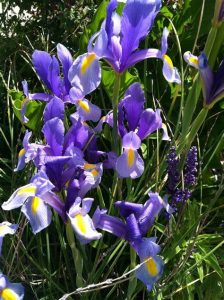
|
Blue Flag IrisHeight: 0.5 m
The Blue Flag Iris is a showy perennial wildflower that typically grows about 0.5 m in height. This plant may also be known by the common name Harlequin Blue Flag. The leaves are light green, sword-shaped, slightly arched or erect, and appear growing out as a cluster around the base of the plant. The attractive blue flowers start to bloom in the early spring, emerging from a tall flowering stalk that can reach up to 1 m. The flowers are beneficial to pollinator species, like bees and butterflies. The seeds are also beneficial to wildlife species, like birds and small mammals.
|
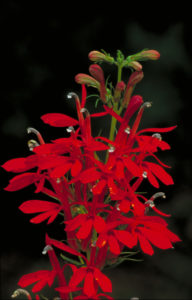
|
Cardinal FlowerHeight: 1 m
Cardinal Flower is an attractive herbaceous perennial wildflower that can grown up to 1 m tall. The leaves are mostly basal, dark green, lance shaped, alternately arranged, and have finely toothed margins. The flowers are showy, bright cardinal red colored, tubular with five lips, appear on an erect terminal spike, and bloom between July and September. The flowers are beneficial for pollinator species, like butterflies and hummingbirds. This is a popular plant choice for wet shoreline properties because of its visual appeal and ornamental value.
|
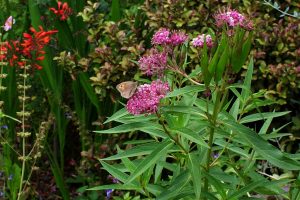
|
Swamp MilkweedHeight: 1 m
Swamp Milkweed is a beautiful wildflower species that typically grows about 1 m tall. The leaves are light green coloured, narrow, lance shaped, and oppositely arranged. The flowers are showy, fragrant, bright pink, appear in clusters on flowering stems, and bloom between July and August. The flowers give way to large, long and narrow, brown seed pods, which produce an abundance of seeds with tufts of long, white hairs. The flowers are beneficial to pollinator species, like bees and butterflies. As with all Milkweeds, the stem exudes a milky sap when broken, however the sap of the Swamp Milkweed is less milky than other species. This sap is critical for caterpillars of the endangered Monarch Butterfly to deter predators.
|
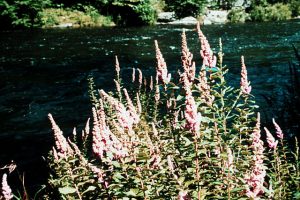
|
SteeplebushHeight: 1 m
The Steeplebush is a deciduous shrub species that typically grows about 1 m in height . This plant may also be known by the common names: Rose Spiraea or Hardhack. The leaves are dark green, about 7 cm long, elliptic to ovate shaped, have toothed margins, and have dense yellowish brown hairs on the undersides. The flowers are tiny, rose pink to purplish coloured, bloom in late summer, and appear on tall, dense, steeple shaped clusters. This plant is useful for controlling erosion and stabilizing shorelines. The flowers are also beneficial for pollinator species, like bees and butterflies.
|
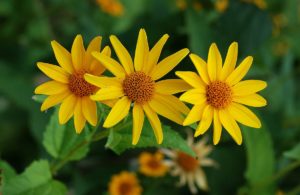
|
Sweet OxeyeHeight: 2m
Sweet Oxeye, also known as False Sunflower, is an attractive, herbaceous, perennial wildflower, which can grow to almost 2 m tall. The flowers are perched atop a stiff stem, with a brownish-yellow center cone surrounded by bright yellow to orange rays. Leaves are 5-12 cm long and 2-8 cm wide, oppositely arranged along the stem, ovate to lanceolate in shape, and have a toothed margin. This wildflower grows best in moist, well-drained soils, preferring full sun, but will tolerate partial shade. Some common natural habitats for the Sweet Oxeye are prairies, meadows, forest edges, and stream banks. Sweet Oxeye is drought tolerant so could be planted in difficult dry sites, but will grow best with regular watering. A large variety of insect species are attracted to the Sweet Oxeye, making it a great addition to a habitat garden.
|
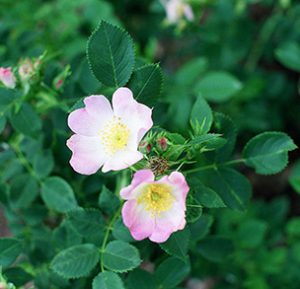
|
Smooth Wild RoseHeight: 1.5m
The Smooth Wild Rose is a shrub species that grows about 1.5 m tall. The name is derived from the fact that it is almost thornless with only a few sharp thorns present near its base. This native shrub is best known for producing beautiful pale pink flowers with five saucer-like petals surrounding a yellow center. The Smooth Wild Rose produces bright red rose hip fruiting bodies which develop during the summer and persist throughout the winter. Leaves produced are alternate and compound, consisting of 5-7 serrated, egg-shaped leaflets.
|
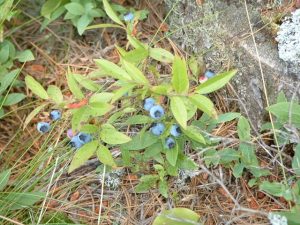
|
Lowbush BlueberryHeight: 60 cm
The Lowbush Blueberry is a low growing, deciduous shrub that only reaches about 60 cm in height. This species grows erect, with many spreading and ascending branches. New branch growth is soft and green-brown in colour, while older branches are woody and have shredded looking bark. The leaves are small, simple leaves alternately arranged, and have finely serrated margins. During the fall, this shrub's lustrous blue-green leaves turn into an electrifying bronze, scarlet or crimson colour. Clusters of small, white, bell-shaped flowers bloom between May and June. By July, the flowers give way to clusters of edible blueberries. These berries provide a significant food source for a variety of bird and mammal species.
|
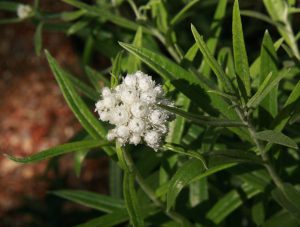
|
Pearly EverlastingHeight: 1m
Pearly Everlasting is a medium sized wildflower species which grows up to 1 m in height. The leaves are grey-green, long and narrow, simple, and alternately arranged. The flowers are small, white colored with yellow centers, have silvery hue appearance, appear in attractive clusters, and bloom between July and August. It is also a great attractant for the American Lady Butterfly because it is a host for its larvae. Historically, Pearly Everlasting was used as a salve to treat burns, bruises, swelling, and joint pain.
|
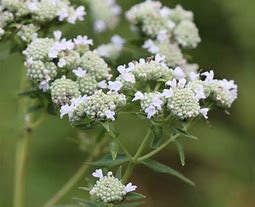
|
Hairy Mountain MintHeight: 1 m
Hairy Mountain Mint is a perennial wildflower species that can grow up to 1 m in height. This plant may also be known by the common name Whorled Mountain Mint. The leaves are green, narrow and lance shaped, have pointed tips, entire margins, and are covered in short dense hairs. The flowers are small, tubular with two-lips, white to lavender colored with purple spotting, and bloom between July and August. The blooms are very beneficial to pollinator species due to the high amounts of nectar produced. This plant has a strong minty fragrance.
|
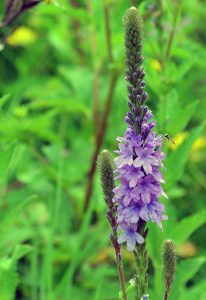
|
Hoary VervainHeight: 1 m
Hoary Vervain is a perennial wildflower species that can grow up to 1 m in height. The leaves are oppositely arranged, grayish green colored, ovate shaped, have toothed margins, and covered in hairs. The flowers are lavender colored, appear in clusters on flowering spikes, and bloom between May and September. The flowers bloom from the bottom of the spike first, opening up toward the tip. The flowers are beneficial to pollinator species , including bees and butterflies. This plant grows easily from seed.
|
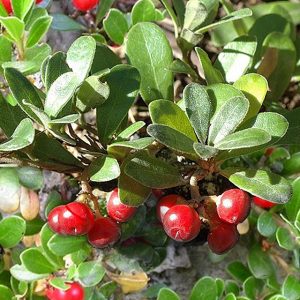
|
BearberryHeight: 20 cm
Bearberry is a low growing, evergreen shrub/ground cover species that grows about 20 cm tall. The leaves are dark green, leathery, shiny, ovate shaped, alternately arranged, and have entire margins. The flowers are tiny, urn shaped, white to pink colored, appear in drooping clusters, and bloom between April and May. Flowers are followed by bright red berries, which remain throughout the fall and winter. These berries are beneficial to wildlife species like birds and small mammals.
|
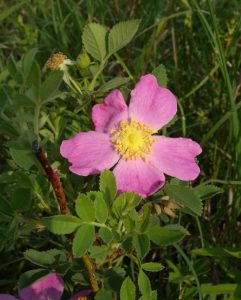
|
Pasture RoseHeight: 1.5 m
The Pasture Rose is a small (1.5m), deciduous shrub which often spreads through suckers to form colonies or thickets in the wild. This species grows erect from a central base with sprawling branches, creating a dense, irregular bush. This shrub produces compound leaves, consisting of 5 to 7 leaflets arranged alternately along the branches. The Pasture Rose yields beautiful 5 centimeter wide white to pink flowers, which bloom in the early summer lasting for approximately a month. The rose hip fruit develops after the flower has died and turns bright red as it ripens. During the fall, the olive green leaves turn yellow to deep red or purple.
|
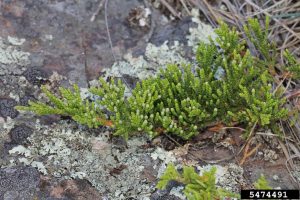
|
Creeping JuniperHeight: 0.5 m
The Creeping Juniper is short, evergreen shrub species that rarely exceeds 0.5 m in height. It produces slender branches, which extend horizontally along the ground and sometimes reach several meters in diameter. The leaves are small, oppositely arranged, scale-like needles with a pointed tip, and are often found in whorls of 3. Throughout the spring and summer, berry-like cones develop along the branches, which turn dark blue by the fall and produce a pale blue-white waxy coating. Creeping Juniper's roots are shallow, with a large main root extending from the center of the plant and smaller roots growing horizontally from the main root. As branches grow along the ground, anchoring roots develop to help hold the juniper to the soil. Due to its extensive root system, the Creeping Juniper is ideal for erosion control, bank stabilization, and soil conservation. This is a popular shrub used for landscaping as a ground cover.
|
Compartment A
Naturalization Area
In area highlighted in white, plant approximately 24 Fireweed plants.
Compartment B
Naturalization Area
Where the diagram indicates to plant Swamp Milkweed, plant Butterfly Milkweed instead. Butterfly milkweed has orange rather than pink blooms.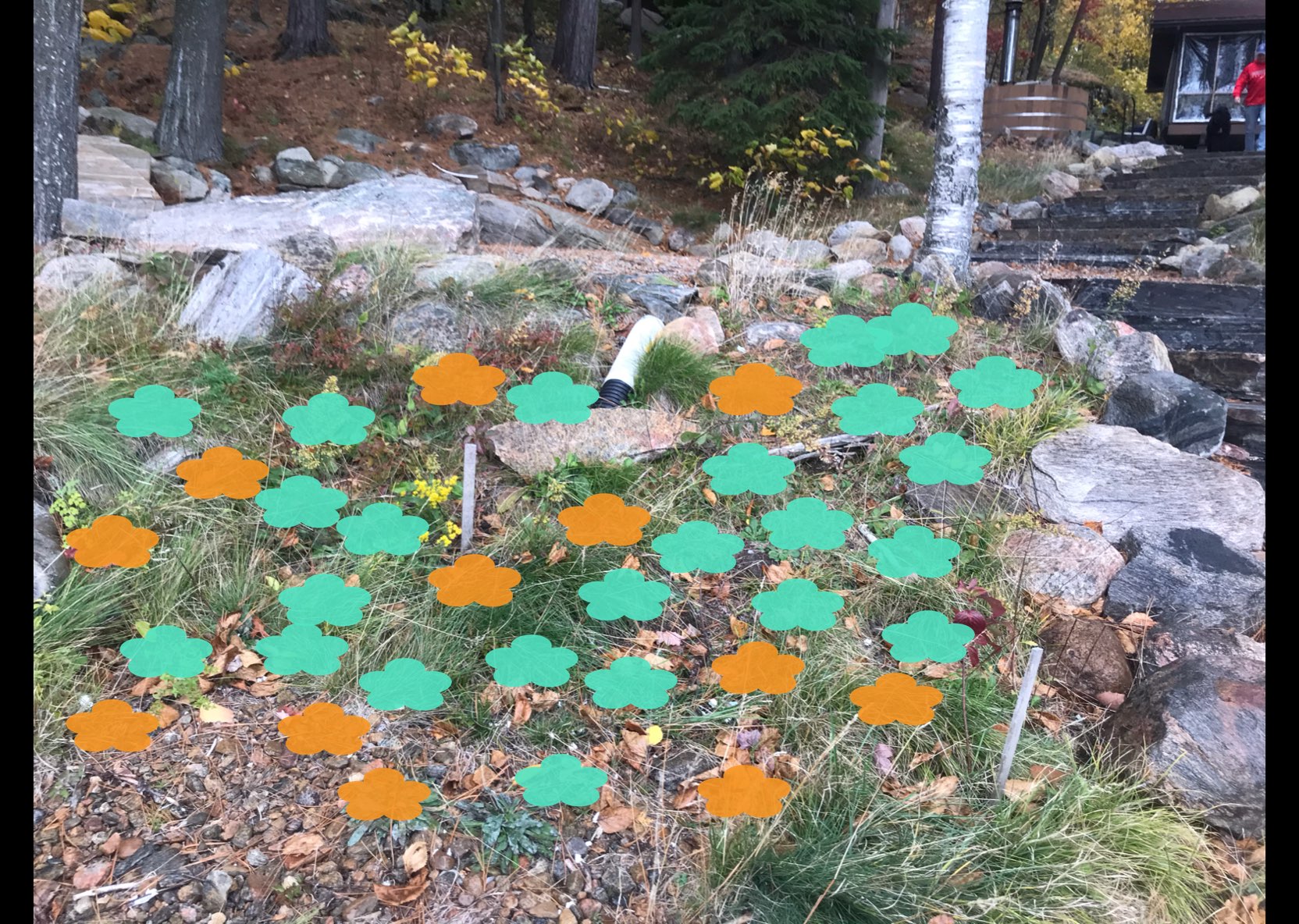
Compartment C
Naturalization Area
In the area highlighted in white square, plant approximately 16 Little Blue Phlox. pH: acidic
pH: acidic-
 Light conditions: partial sun
Light conditions: partial sun
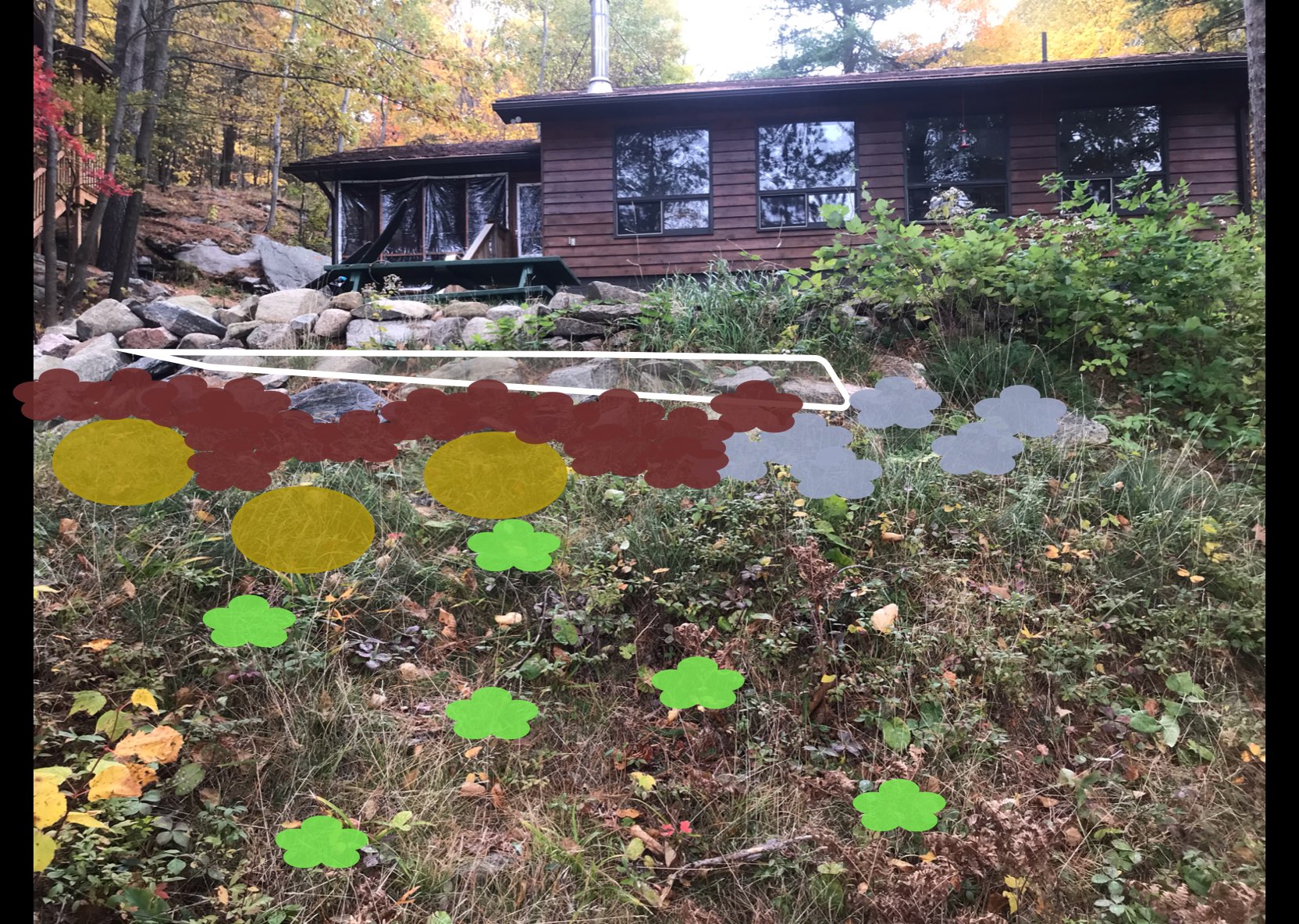
Compartment D
Naturalization Area
In area highlighted in white square, plant Northern Bayberry. It is a tall shrub that will grow to block the view of the space under the cottage.-
 Moisture: dry
Moisture: dry -
 Light conditions: full sun, partial sun
Light conditions: full sun, partial sun
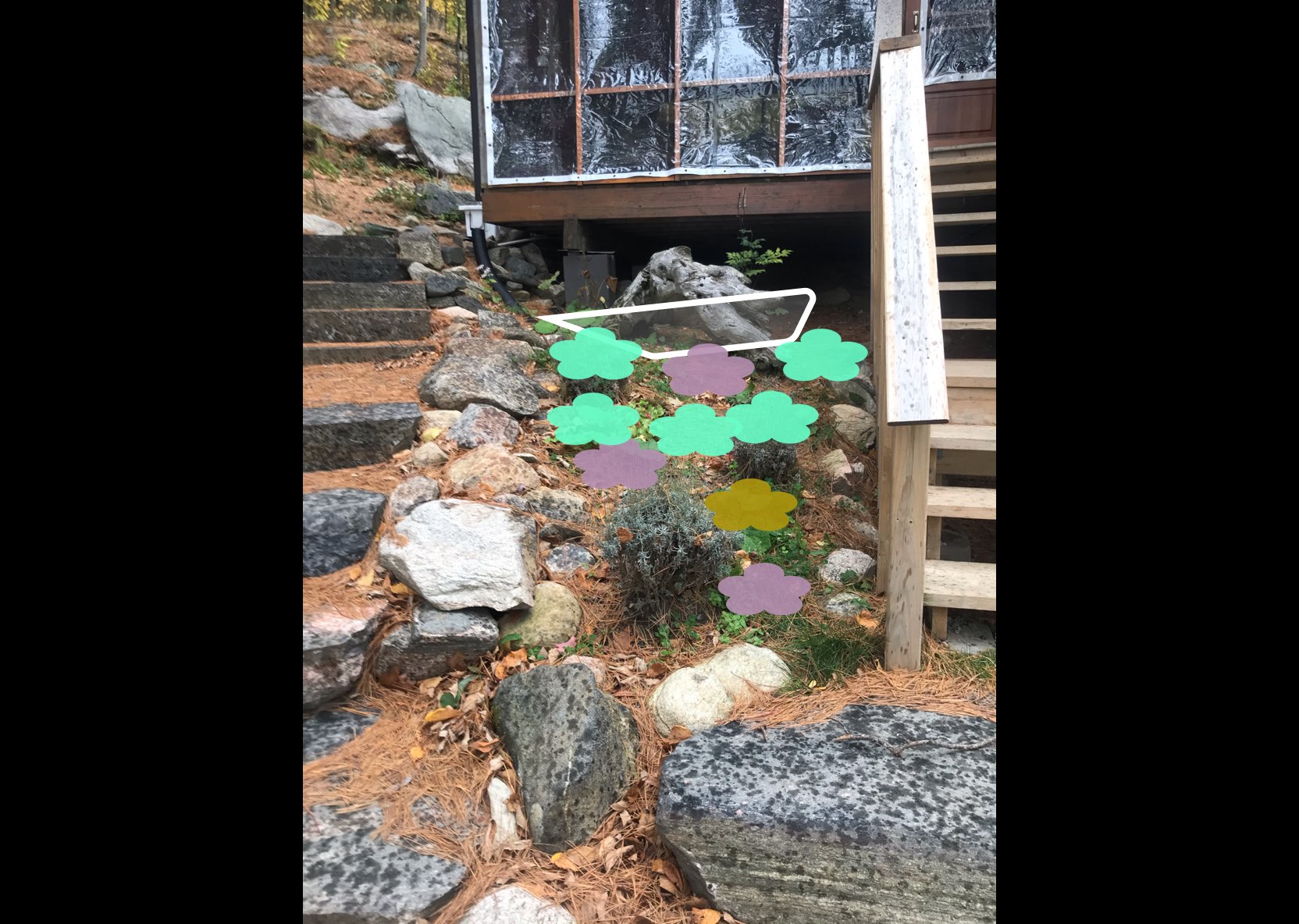
Compartment E
Naturalization Area
Hill leading to bunkie - no photo taken pH: acidic
pH: acidic-
 Moisture: dry
Moisture: dry -
 Light conditions: full sun
Light conditions: full sun
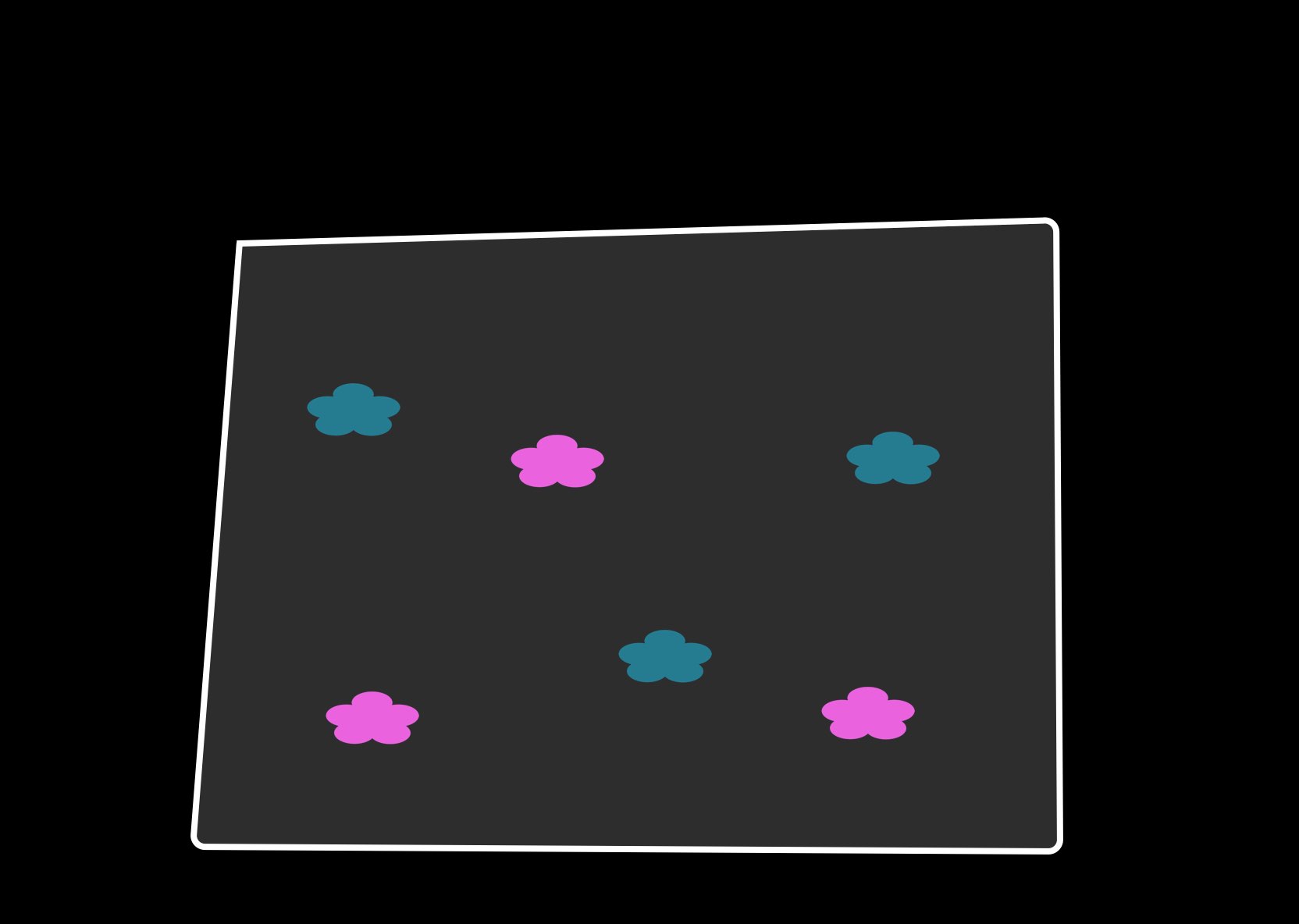
Compartment F
Naturalization Area
Small circular patch at the top of the stairs - plant Ostrich Fern.-
 Light conditions: shade
Light conditions: shade

Schedule B
Financial Summary
Project by: The Land Between charity
Shoreline Re-Naturalization Starter Kit includes: free site visit, customized re-naturalization planting plan for your shoreline property, native plants including free bare root (small) and potted (large) plants and wildflowers, coconut fibre pads to deter grass from growing around new plantings, tree guards for all deciduous trees, mulch for your wildflowers, Plant Care Guide with instructions on how to take care of your new plants, Habitat Creation Guide and a Wildflower Garden Guide.
Our planting plans are created onsite with you and provide detailed information and plans to re-naturalize your shoreline property. We take photos of areas for planting and overlay native plants that are well suited to your property based on site conditions such as soil type and sunlight availability.
We will work with you to create a plan that works for you including options for low growing plants in areas where views are important.
| Item | Quantity | Cost/Item | Subtotal |
|---|---|---|---|
| Starter Kit fee | $250 | ||
| Free potted plants | 8 | $0 | $0 |
| Paid potted plants | 3 | 13.00 | 39.00 |
| Free bareroot plants | 0 | $0 | $0 |
| Free wildflowers | 10 | $0 | $0 |
| Paid wildflowers | 121 | 10.00 | 1210.00 |
| Total costs | 1499.00 |
Schedule C
Project Agreement
Stewardship Agreement
Please indicate your agreement to this proposed plan by signing the following Stewardship Agreement and submitting it, along with your financial contribution, to:
The Land Between charity
Box 1368, 6712 Gelert Road,
Plant Availability
Please note that plant species may need to be changed based on plant stock availability at the time of ordering.
Project Completion
Upon receiving your signed stewardship agreement and financial contribution, a date will be booked for you to pick up your Natural Edge Kit. The Land Between charity will supply all plants and materials. If you are paying for the planting to be completed for you, a date will be arranged for The Land Between charity to plant your shoreline, bringing the plants and materials with them. If there are particular dates that you would prefer, we will do our best to accommodate your requests.
The Natural Edge Stewardship Agreement with The Land Between charity
Agreement made this Day of the Month of in the Year .
BETWEEN Ryan Vincent 1128 Juniper Court Haliburton Ontario (Hereinafter called the OWNERS)
AND The Land Between charity Box 1368, 6712 Gelert Road, (Hereinafter called TLB)
WHEREAS the Owners and TLB have met and discussed plans for shoreline naturalization on the specified area(s) in Schedule A existing on the Owners’ land;
WHEREAS the Owners indicate approval of the project as proposed; and
WHEREAS the project is, or will be for the benefit of the Owners and others;
NOW THEREFORE THE PARTIES AGREE AS FOLLOWS:
1. This Agreement shall be in effect for a period of 5 years, commencing with the date of this Agreement.
2. The Owners and TLB agree that the areas where the work is to be performed is as described in Schedule A.
3. The Owners agree to pick up their Natural Edge Starter Kit from TLB’s office and plant their shoreline within two days of receipt. The Owners will provide “after” photos of the work completed to be used for reporting purposes. If the Owners wish to have the planting completed for them, then TLB or it’s contractors, employees and agents will complete the planting at cost, as indicated in Schedule B.
4. If the planting is to be completed by TLB, then the Owners grant TLB, its contractors, employees and agents, the right to enter the property to perform the work agreed upon as outlined in Schedule A. In addition, TLB, its contractors, employees and agents may inspect the work performed for the purposes of monitoring the project and survival assessment, with prior agreement with Owners for date and time of inspection.
5. The Owners agree to contribute the “Landowner contribution” and pay the costs indicated in Schedule B.
6. In instances where the Owners are to pay TLB for work to be performed (outlined in Schedule A), the Owners agree to provide payments to TLB prior to the commencement of that operation. Failure of payment shall constitute a breach of this Agreement and the Owners agree that this Agreement will be terminated and thereupon the Owners agree to pay TLB the estimated costs of the operations of the project completed to date, if any.
7. The Owners agree, if necessary, to perform a reasonable amount of maintenance, which is described in the Native Plant Care Guide, available at naturaledge.watersheds.ca.
8. If a contractor is required to perform the work outlined in Schedule A, then the contractor carrying out the work on the land described will be required to take out and furnish evidence of a comprehensive policy of public liability and property damage coverage. The contractor and their workers will be required to be in good standing with the Workplace Safety and Insurance Board (WSIB) prior to performing the work.
9. The Owners agree not to remove, destroy or alter the project without prior consultation and approval of TLB. Pruning and trimming planted nursery stock, or adding replacement native nursery stock is exempt.
10. The Owners agree not to mow the planted area.
11. The Owners do acknowledge that TLB, its contractors, employees and agents, having performed said works, are not under further obligation with respect to survival of nursery stock, inspection, or maintenance.
12. The Owners, in the absence of negligence, hereby remise, release and forever discharge TLB, its contractors, employees and agents from all claims and demands for injuries, including death, loss, damages and costs in any way related to or connected with installation and maintenance of the work described or resulting from any deleterious effects of the work to the land or to the lands and buildings thereon retained by the Owners.
IN WITNESS WHEREOF the parties have agreed to the contents of this plan; SIGNED:
About this program
About The Land Between charity
The Land Between is a region stretching across south-central Ontario from the Georgian Bay Coastline to the Ottawa River. It lies between the Canadian Shield and St. Lawrence Lowlands and has species from both north and south. The region has the highest habitat diversity in Ontario; more lakes, wetlands, and rivers than anywhere in the province; the majority of rock barrens and alvar habitats; and is home to more skinks, turtles, hummingbirds than anywhere in Ontario. It is melting pot of species diversity and the last refuge for many disappearing wildlife and important mammals in southern Ontario. The Land Between charity cares for and conserves this region through community based and multi partnered programs, by working with landowners and through grit and perseverance. The Land Between charity is Cottage Country's own conservation organization.
This program was created by Watersheds Canada
We believe that every person has the right to access clean and healthy lakes and rivers in Canada. At Watersheds Canada, we work to keep these precious places naturally clean and healthy for people and wildlife to continue using for years to come. We love working with others to meet the needs of local communities, whether you’re a concerned citizen, a landowner, a lake association looking for help, or a coalition of groups interested in activating your local community.

